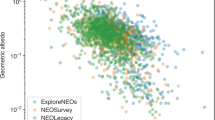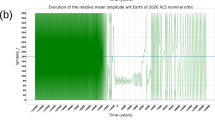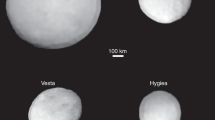Abstract
Evidence for asteroidal satellites (moons) has been sought for decades, because the relative frequency of such satellites will bear on the collisional history of the asteroid belt and the Solar System, yet only one has been detected unambiguously1,2,3. Here we report the discovery of a satellite of the asteroid 45 Eugenia, using an adaptive optics system on a ground-based telescope. The satellite has a diameter of about 13 km, and an orbital period of about 4.7 days with a separation of 1,190 km from Eugenia. Using a previously determined4 diameter for Eugenia, we estimate that its bulk density is about 1.2 g cm-3, which is similar to that of the C-type asteroid Mathilde5,6. This implies that Eugenia, also a low-albedo C-type asteroid, may be a rubble pile, or composed of primitive, icy materials of low bulk density.
This is a preview of subscription content, access via your institution
Access options
Subscribe to this journal
Receive 51 print issues and online access
$199.00 per year
only $3.90 per issue
Buy this article
- Purchase on Springer Link
- Instant access to full article PDF
Prices may be subject to local taxes which are calculated during checkout



Similar content being viewed by others
References
Belton,M. J. S. et al. Bulk density of asteroid 243 Ida from the orbit of its satellite Dactyl. Nature 374, 785–788 (1995).
Belton,M. J. S. et al. The discovery and orbit of 1993(243)1 Dactyl. Icarus 120, 185–199 (1996).
Chapman,C. R. et al. Discovery and physical properties of Dactyl, a satellite of asteroid 243 Ida. Nature 374, 783–785 (1995).
Tedesco,E. F., Veeder,G. J., Fowler,J. W. & Chillemi,J. R. The IRAS Minor Planet Survey—Final Report (PL-TR-92-2049, Phillips Laboratory, Hanscom Air Force Base, MA, 1992).
Veverka,J. et al. NEAR's flyby of 253 Mathilde: images of a C-asteroid. Science 278, 2109–2114 (1997).
Yeomans,D. K. et al. Estimating the mass of asteroid 253 Mathilde from tracking data during the NEAR flyby. Science 278, 2106–2109 (1997).
Weidenschilling,S. J., Paolicchi,P. & Zappalà,V. in Asteroids II (eds Binzel, R., Gehrels, T. & Matthews, M.) 643–658 (Univ. Arizona Press, Tucson, 1989).
Van Flandern,T. C., Tedesco,E. F. & Binzel,R. P. in Asteroids (ed. Gehrels, T.) 443–465 (Univ. Arizona Press, Tucson, 1979).
Gehrels,T., Drummond,J. D. & Levenson,N. A. The absence of satellites of asteroids. Icarus 70, 257–263 (1990).
Chauvineau,B. & Mignard,F. Dynamics binary asteroids II. Jovian perturbations. Icarus 87, 377–390 (1990).
Bottke, W. F. Jr & Melosh,H. J. Formation of asteroidal satellites and doublet craters by planetary tidal forces. Nature 381, 51–53 (1996).
Durda,D. D. The formation of asteroidal satellites in catastrophic collisions. Icarus 120, 212–219 (1996).
Merline,W. J. et al. NEAR's encounter with 253 Mathilde: Search for satellites. Proc. Lunar Planet. Sci. Conf. XXIX, abstract no. 1954 (1998).
Merline,W. J. et al. Search for satellites around asteroid 433 Eros from NEAR flyby imaging. Proc. Lunar Planet. Sci. Conf. XXX, abstract no. 2055 (1999).
Merline,W. J. et al. in S/1998(45)1. IAU Circ. No. 7129, (1999).
Drummond,J. D., Weidenschilling,S. J., Chapman,C. R. & Davis,D. R. Photometric geodesy of main-belt asteroids. II. Analysis of lightcurves for poles and shapes. Icarus 73, 314–323 (1988).
Taylor,R. C., Birch,P. V., Pospieszalska-Surdej,A. & Surdej,J. Asteroid 45 Eugenia: lightcurves and pole orientation. Icarus 73, 314–323 (1988).
Durda,D. D. & Geissler,P. E. The formation of asteroidal satellites in large cratering collisions. Bull. Am. Astron. Soc. 28, 1101 (1996).
Chauvineau,B., Farinella,P. & Mignard,F. Planar orbits about a triaxial body: Applications to asteroidal satellites. Icarus 105, 370–384 (1993).
Sheeres,D. J. Dynamics about uniformly rotating tri-axial ellipsoids. Icarus 110, 225–238 (1994).
Hamilton,D. P. & Burns,J. A. Orbital stability zones about asteroids. Icarus 92, 118–131 (1991).
Harris,A. W., Young,J. W., Bowell,E. & Tholen,D. J. Asteroid lightcurve observations from 1981–1983. Icarus (in the press).
Gradie,J. & Flynn,L. A search for satellites and dust belts around asteroids: negative results. Proc. Lunar Planet. Sci. Conf. XIX, 405–406 (1988).
Storrs,A. et al. Imaging observations of asteroids with Hubble Space Telescope. Icarus 137, 260–268 (1999).
Belton,M. J. S. et al. Galileo encounter with 951 Gaspra: First pictures of an asteroid. Science 257, 1647–1652 (1992).
Veverka,J. et al. Imaging of asteroid 433 Eros during NEAR's flyby reconnaissance. Science 285, 562–564 (1999).
Mottola,S. & Lahulla,F. Mutual eclipse events in binary asteroid system 1996 FG3: observations and a numerical model. Asteroids, Comets, Meteors '99, paper 24.03 (1999): 〈http://scorpio.tn.cornell.edu/ACM/web_abs.html〉.
Pravec,P., Wolf,M., Sarounova,L. Occultation/eclipse events in binary asteroid 1991 VH. Icarus 133, 79–88 (1998).
Davis,D. R., Chapman,C. R., Durda,D. D., Farinella,P. & Marzari,F. The formation and collisional/dynamical evolution of the Ida/Dactyl system as part of the Koronis family. Icarus 120, 220–230 (1996).
Chapman,C. R., Paolicchi,P., Zappalà,V., Binzel,R. P. & Bell,J. F. in Asteroids II (eds Binzel, R., Gehrels, T. & Matthews, M.) 386–415 (Univ. Arizona Press, Tucson, 1989).
Bus,S. J. Compositional Structure in the Asteroid Belt: Results of a Spectroscopic Survey. Thesis, Massachusetts Inst. Technol. (1999).
Zappalà,V., Bendjoya, Ph., Cellino,A., Farinella,P. & Froeschle,C. Asteroid families: Search of a 12,487-asteroid sample using two different clustering techniques. Icarus 116, 291–314 (1995).
Roddier,F. Curvature sensing and compensation: a new concept in adaptive optics. Appl. Opt. 27, 1223–1225 (1988).
Roddier,F., Northcott,M. & Graves,J. E. A simple low-order adaptive optics system for near infrared applications. Publ. Astron. Soc. Pacif. 103, 131–149 (1991).
Rigaut,F. et al. Performance of the Canada-France-Hawaii Telescope adaptive optics bonette. Publ. Astron. Soc. Pacif. 110, 152–164 (1998).
Acknowledgements
W.J.M., L.M.C., C.D., F.R., F.M. and G.D. are visiting astronomers at the Canada-France-Hawaii Telescope (CFHT), operated by the National Research Council of Canada, the Centre National de la Recherche Scientifique of France and the University of Hawaii. This work was done using observing time allocated through the University of Hawaii and granted by the CFHT Corporation, and was supported by funding from NASA and the NSF. We thank the staff of CFHT, particularly J.-L. Beuzit, for their logistical support; M. Northcott and J. E. Graves for development of a prototype instrument; and W. Colwell for assistance with data analysis tools.
Author information
Authors and Affiliations
Corresponding author
Rights and permissions
About this article
Cite this article
Merline, W., Close, L., Dumas, C. et al. Discovery of a moon orbiting the asteroid 45 Eugenia. Nature 401, 565–568 (1999). https://doi.org/10.1038/44089
Received:
Accepted:
Issue Date:
DOI: https://doi.org/10.1038/44089
This article is cited by
-
Small Solar System Bodies as granular media
The Astronomy and Astrophysics Review (2019)
-
The EURONEAR Lightcurve Survey of Near Earth Asteroids
Earth, Moon, and Planets (2017)
-
Equilibrium Points and Periodic Orbits in the Vicinity of Asteroids with an Application to 216 Kleopatra
Earth, Moon, and Planets (2015)
-
A review of comet and asteroid statistics
Earth, Planets and Space (2014)
-
Asteroids with Satellites: Inventory, Properties, and Prospects for Future Discoveries
Earth, Moon, and Planets (2009)
Comments
By submitting a comment you agree to abide by our Terms and Community Guidelines. If you find something abusive or that does not comply with our terms or guidelines please flag it as inappropriate.



